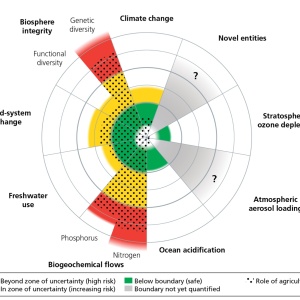
The planetary boundaries concept provides a theoretical upper limit on human activity which the planet is able to sustain without major perturbation to the current ‘Earth system’. Previously, nine planetary boundaries (PBs) have been proposed and recently Steffen et al. (2015) have updated these boundary definitions and assessed the current state of the position of human activity with respect to each boundary. In this article, researchers from a number of food, climate change, agricultural and environmental research institutions around the world build on this work by assessing the impact of agriculture on each PB status, based on a detailed literature review of the available research.
Their findings are summarised below (by PB):
- Land system change (e.g. the conversion of natural ecosystems to cropland and pastures). Steffen et al found that current human activity is within the range of uncertainty around this boundary with increasing risk of breaching it. The current article proposes that at present approximately 80% of this current activity estimate is attributable to agricultural land use change.
- Freshwater use. The authors provide an update on the current freshwater boundary position and estimate that we are within the uncertainty region for breaching it. They also estimate that agriculture’s role is at present 84% of the planetary boundary allowance. However they discuss in detail the difficulties in estimating the freshwater PB.
- Biogeochemical flows (i.e. the combined effect of nitrogen and phosphorus usage on their respective natural cycles). The authors consider the nitrogen and phosphorus cycles separately. They propose that the relative effect of agriculture on the planetary boundary are approximately 85% and over 90% for nitrogen and phosphorus respectively.
- Changing biosphere integrity. The authors comment on the difficulty in assessing biodiversity indicators and estimate agriculture’s impact on biodiversity integrity to be approximately 80%.
- Climate change. The authors consider only carbon dioxide usage for agriculture’s impact on climate change, which they state is approximately 25% due to agriculture. This analysis notably neglects other greenhouse gas emissions due to agriculture, such as methane primarily from livestock, which may account for a more significant proportion of agriculture’s contribution to climate change.
- Ocean acidification. The authors highlight regional aspects and difficulty in measuring ocean acidification at the global scale. In the absence of additional information, they estimate that agriculture drives the change in this area by about 25% i.e. in proportion to the CO2 estimates above.
- Stratospheric ozone depletion. The authors highlight the continuing effect of chlorofluorocarbon emissions (largely not agriculturally derived) as having an ongoing role in ozone depletion. However, looking to the future, they assess the impact of N2O as a cause of ozone depletion and highlight that at present between 66 and 90% of human N2O emissions are attributed to agriculture. At present, they estimate the effect of agriculture on the planetary boundary to 5% but highlight that clearly this will increase in the future.
- Atmospheric aerosol loading (i.e. particulate matter). The authors highlight that there is no global boundary due to the difficulties in assessing particulate matters on a global scale. We refer the reader to the full article for extensive discussion, but briefly the authors propose a new global boundary and estimate the effect of agriculture to be 11%.
- Introduction of novel entities. This planetary boundary builds on that previously defined as ‘chemical pollution’ and assesses the impact of pesticides. The authors also include a discussion of the ongoing debate as to whether genetically modified organisms should be included in this boundary.
Throughout the article the authors comment on the regional aspects of each planetary boundary providing an interesting perspective on the use of ‘lumped’ global parameters in assessing the health of the current Earth system. Additionally the authors provide a number of potential amelioration mechanisms for each of these nine planetary boundaries - please refer to the full article for an extensive discussion.
Abstract
We explore the role of agriculture in destabilizing the Earth system at the planetary scale, through examining nine planetary boundaries, or “safe limits”: land-system change, freshwater use, biogeochemical flows, biosphere integrity, climate change, ocean acidification, stratospheric ozone depletion, atmospheric aerosol loading, and introduction of novel entities. Two planetary boundaries have been fully transgressed, i.e., are at high risk, biosphere integrity and biogeochemical flows, and agriculture has been the major driver of the transgression. Three are in a zone of uncertainty i.e., at increasing risk, with agriculture the major driver of two of those, land-system change and freshwater use, and a significant contributor to the third, climate change. Agriculture is also a significant or major contributor to change for many of those planetary boundaries still in the safe zone. To reduce the role of agriculture in transgressing planetary boundaries, many interventions will be needed, including those in broader food systems.
Reference
Campbell, B.M., Beare, D.J., Bennett, E.M., Hall-Spencer, J.M., Ingram, J.S.I., Jaramillo, F., Ortiz, R., Ramankutty, N.J.A., Sayer, N. and Shindell, D. (2017). Agriculture production as a major driver of the Earth system exceeding planetary boundaries. Ecology and Society 22(4):8.
You can read the full article here.







Post a new comment »